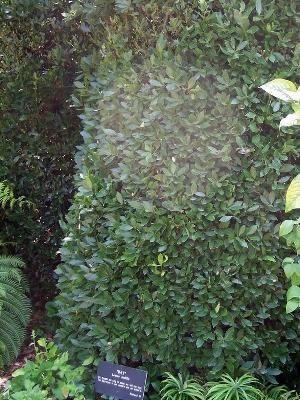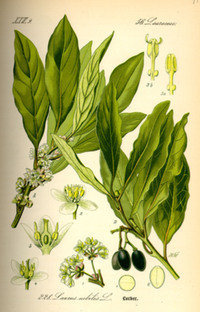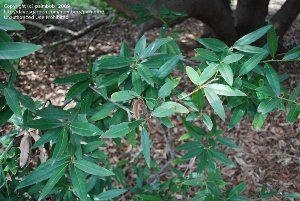





The 2009 herb of the year is (drum-roll, please) bay laurel or sweet bay! This woody, aromatic perennial tree native to the Mediterranean has many reasons to be celebrated, both for its historic significance and its usefulness today. But is California bay almost as good? Please, read on.
What shall we call it?
Laurus nobilis has many names. I always simply called its leaves "bay leaves" when cooking, and indeed, that is how it is referred to in most cookbooks. Gardeners, however, know this lovely aromatic tree as "sweet bay," "bay laurel" or "Grecian bay," or by one of its cultivar names. L. nobilis grows wild in Israel and at one time, according to Arthur Tucker, at least twenty-one distinct varieties of bay were catalogued there, with leaves varying from small and short to big and long, sizes ranging from 6 feet to 60 feet in height!
How to grow it
Laurus nobilis in cultivation

L. nobilis is happiest in its native Mediterranean basin or similar climates. According to PlantFiles entries, it can survive temperature extremes from 30° to over 100° F. Liking fertile, well-drained soil, sweet bay can be grown indoors, in a pot in a bright, sunny window and brought outside when the weather is consistantly above freezing.
How to cook with it (why fresher isn't better)
With L. nobilis, the leaf is the only part that is used in cooking. The essential oils present in L. nobilis become more concentrated as the glossy, olive-green leaf dries, so unlike most herbs, this one is more flavorful dried! This doesn't mean if you're lucky enough to own a live plant, you can't pluck a leaf and toss it into the stew; feel free. Just be sure it's really the genuine L. nobilis and not one of its look-alike imposters.
Bouquet Garni
Bouquet garni is a French term that has come to mean a bunch or bag of herbs tied together and used during cooking (of stews, stocks or soups) but removed before serving. Whether tied as bundle, placed in a cloth "bouquet garni bag" or in a large metal tea ball, the herbs in a bouquet garni vary, including among them herbs like savory, thyme, parseley, rosemary, chervil, or celeriac but always including a bay leaf.
Leaves in? leaves out?
One of the reasons the bouquet garni is removed before serving is that the bay leaf never becomes soft and easy to eat; it remains stiff and unpleasant. There is a custom that the guest who ends up with a bay leaf will come into various types of good fortune.  As the cook, I am usually berated by my family for neglecting to remove the inedible wad. (They don't realize how tasteless the meal would have been without it!) However, there is apparently a good reason for removing the bay leaf; there are cases where bay leaves have caused irritation to the esophagus when inadvertantly swallowed. The leaves of L. nobilis are not toxic.
As the cook, I am usually berated by my family for neglecting to remove the inedible wad. (They don't realize how tasteless the meal would have been without it!) However, there is apparently a good reason for removing the bay leaf; there are cases where bay leaves have caused irritation to the esophagus when inadvertantly swallowed. The leaves of L. nobilis are not toxic.
Look-alike imposters—don't eat these!
If you search in PlantFiles for bay or laurel you will find a host of plants with bay or laurel in the name, most of which are poisonous. For instance, the Common Laurel, also called English Laurel or Cherry Laurel, has twenty varieties listed, which are beautifully ornamental and resemble our L. nobilis but cannot be eaten. Then there's Poet's Laurel, Danae racemosa, or a small evergreen bush, and Laurel clock-vine, Thunbergia laurifolia, a tropical vine; the mountain laurels, Kalmia latifolia, attractive temperate zone shrubs, again with elipitical, leathery, evergreen leaves, and again poisonous if ingested.
California Bay
California bay, Umbellularia californica, is very much like Laurus nobilis, so much so that Spice Islands brand sells U. californica leaves as "California bay leaves" in my New England supermarket. (The two trees are unrelated, however.) It
Umbellularia californica
bears the same familiar aromatic leaves and grows into full trees in the same, Mediterranean-type climate (i.e., California and southern Oregon). Penzey's compares the two in flavor, saying L. nobilis has "a natural depth of flavor that the California bay leaves can't hope to match."
Craft Uses
Ever since the first Greek realized that the tough, leathery, evergreen leaves of L. nobilis could be formed into a wreath, crown or garland suitable for adorning the heads of nobility or marathon winners, bay leaves have been used in crafts. They still are today, although the fresh bay leaves sold in the vegetable section of my grocery store today were too expensive for anything other than adding to the spaghetti sauce. However, if you have access to many fresh bay leaves, you may find them useful for fragrant wreaths or for adding to potpourris.
Other Uses
L. nobilis was and is still used medicinally, primarily as an external poultice or as an insecticide. It is suggested that it might be effective against fleas, mosquitoes, cereal moths and wool moths, all of which plague my house.
But what does it smell or taste like, anyway?
I read a great many descriptions of the scent and flavor of sweet bay in the course of my research for this article, and my best approximation is eucalyptus/menthol/lemon/balsam/mint/rosemary. Er ... yeah. Precisely. Try a leaf in the water next time you boil potatoes to isolate the wonderful flavor of bay. Bay leaves are even ground up and used in blends with other seasonings just for seafood.
Bay Rum
Bay Rum is an aftershave or cologne made of an distillation of leaves of Pimenta racemosa, or the Caribbean bay tree, with rum (another product of the Caribbean) and water. (Distilling concentrates a plant's essence; in this case, chopping up the Caribbean bay leaves with rum and water would allow the essential oils to be dissolved by the rum and concentrated when the rum and water mixture boiled off.) P. racemosa is another aromatic evergreen with ovate leaves, native to the Caribbean and Central America. "Bay Rum" is not a type of rum, although I believe the name "bay" has been appropriated by at least one brand of Caribbean rum. The only other member of the Pimenta genus is a similar plant from which the spice allspice is harvested. Although P. racemosa, Caribbean bay, or Bay rum tree, is also used in regional cooking, I don't have any advice on using it, nor do I know anything about its toxicity. It might be good for laurel wreaths, though. 
There is at least one recipe available online for "homemade bay rum" in which you stuff a Mason jar with "bay leaves" and pour rum over them, then wait six months. Since the recipe didn't specify P. racemosa, it's not remotely like Bay Rum. Bay Rum, as a cologne or aftershave, was especially popular in the first third of the twentieth century, and most Bay Rum aftershaves or colognes ended up being brands, owned either by Caribbean companies or by British ones.
What do all three "bay leaves" have in common?
They are all three highly fragrant, aromatic evergreen trees growing in tiny genera of one or two members. (Laurus has one other member, the Canary Island bay, L. azorica, Umbellularia californica is the only plant in its genus and the Pimenta genus, as I mentioned, has one other member.) Each has its own geographical niche; the Mediterranean, the West coast of the United States, or the Caribbean, yet all three are high in similar terpenoids (the essential oils that give spices their flavor). All three are used locally in herbal medicine. But the 2009 Herb of the Year is Laurus nobilis, Sweet bay, Grecian bay, bay laurel—that one. As for the other bay leaves, they will have to wait their turn!
For more information please click on the links below.
Herb Society of America Guide to Bay
Plant Names from Myth: Daphne Lois Tilton's article about the origination of the name "laurel"
Mountain Laurel Memories Sharon Brown discusses the laurel you don't eat.
Copyright © www.100flowers.win Botanic Garden All Rights Reserved